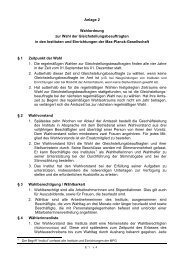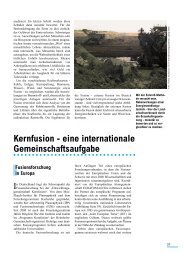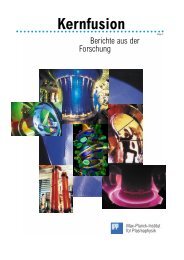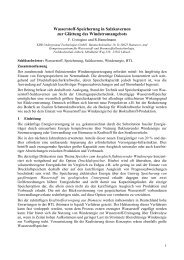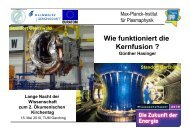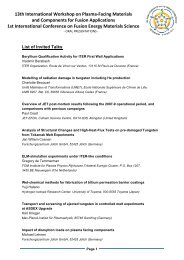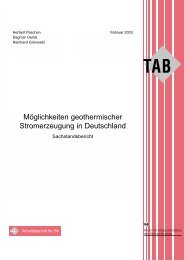IPP Annual Report 2007 - Max-Planck-Institut für Plasmaphysik ...
IPP Annual Report 2007 - Max-Planck-Institut für Plasmaphysik ...
IPP Annual Report 2007 - Max-Planck-Institut für Plasmaphysik ...
You also want an ePaper? Increase the reach of your titles
YUMPU automatically turns print PDFs into web optimized ePapers that Google loves.
<strong>Max</strong> <strong>Planck</strong> Junior Research Group<br />
“Turbulence in Magnetized Plasmas”<br />
Head: Dr. Wolf-Christian Müller<br />
Turbulent Convection<br />
Turbulence driven by thermal fluctuations around a mean<br />
temperature gradient plays a role in various physical systems<br />
like the Sun, the earth’s atmosphere, and fusion plasmas.<br />
Large scale direct numerical simulations of turbulent convection<br />
in plasmas as well as neutral fluids described in the Boussinesq<br />
approximation were performed using a parallel pseudospectral<br />
code in fully periodic geometry. Two dimensional magnetohydrodynamic<br />
(MHD) convective turbulence shows self-excited<br />
quasi-oscillations between regimes that are either dominated by<br />
buoyancy or by inertial forces depending on the mutual alignment<br />
between velocity and magnetic field. In addition, a simulation of<br />
a three-dimensional hydrodynamic system with 20483 collocation<br />
points has been started, making this simulation the largest<br />
numerical effort in turbulent convection world-wide. To this end,<br />
the numerical code has been highly optimized for the HLRBII<br />
supercomputer at the Leibniz computing centre in Garching.<br />
Lagrangian Statistics of Turbulence<br />
Turbulent transport is a key feature of many physical problems<br />
such as plasma confinement in fusion devices, the turbulent<br />
dynamo, or the propagation of cosmic rays in the interstellar<br />
medium. The diffusive characteristics of turbulence are best<br />
studied from the Lagrangian viewpoint. Lagrangian statistics<br />
of incompressible magnetohydrodynamic turbulence are obtained<br />
by tracking tracer particles in direct numerical simulations.<br />
A full parallelization of the particle tracking scheme has<br />
made it possible to use up to 1024 parallel processes. In MHD<br />
turbulence under the influence of a mean magnetic field turbulent<br />
diffusion and relative dispersion of the tracer particles<br />
has been found to be enhanced in the direction of the mean<br />
magnetic field. The results agree with the picture which has<br />
been developed for macroscopically isotropic MHD turbulence.<br />
Turbulent flows are commonly driven by temperature gradients.<br />
Therefore, Lagrangian tracers have been added to the<br />
large HLRBII-run of convective Navier-Stokes turbulence.<br />
Compressible Turbulence<br />
Within the Cluster of Excellence “Origin and Structure of the<br />
Universe” the efforts to study supersonic turbulence focus on<br />
turbulent dynamics which are probably of importance for starand<br />
structure-formation in the interstellar medium. To this end,<br />
a new numerical framework is being developed to work reliably<br />
on turbulent configurations with Mach numbers greater than<br />
five. Special attention is paid to a low dissipation approach since<br />
thin and sharply resolved shock fronts are a dominant feature<br />
of supersonic turbulence. The new 2D and 3D compressible<br />
MHD codes are able to capture shocks while maintaining the<br />
divergence free constraint on the magnetic field. The underlying<br />
Theoretical Plasma Physics<br />
89<br />
numerical scheme of Kurganov-Tadmor type in combination<br />
with third order CWENO reconstruction is built on central differences<br />
meeting the requirements of low numerical dissipation and<br />
of high precision. The code has been successfully tested for accuracy<br />
and for its shock capturing ability and is currently being parallelized.<br />
The project represents a direct point of contact with astrophysics<br />
groups of the MPA (Hillebrandt) and LMU (Burkert).<br />
Structure Formation in MHD Turbulence<br />
Magnetic helicity quantifies various structural aspects of a<br />
magnetic field. It is important in reversed-field-pinch experiments<br />
as well as in astrophysical plasmas since its dynamics<br />
is believed to be the cause of large scale magnetic structures<br />
accompanying many celestial bodies. We study the associated<br />
inverse cascade, i.e., the self-similar spectral transport from<br />
small scales to large scales by means of direct numerical simulations<br />
of 3D MHD turbulence. Systems with small scale drive<br />
of turbulence and magnetic helicity have been set up resulting<br />
in a clearly established cascade process whose characteristics<br />
are in contradiction to all known theories. Current studies<br />
focus on a more realistic representation of the small scale<br />
dynamics of turbulence to verify this finding. In a complementary<br />
activity, the behaviour of magnetic helicity in decaying<br />
3D MHD turbulence is investigated numerically.<br />
Fundamental Properties of Turbulence<br />
The investigation of anisotropic cascade dynamics in MHD turbulence<br />
permeated by a strong mean magnetic field is continued.<br />
Recent numerical experiments as well as detailed diagnostics<br />
of large scale simulations have led to serious doubts about the<br />
validity of the well-accepted Goldreich-Sridhar picture of anisotropic<br />
turbulence. Further efforts will be necessary to corroborate<br />
this claim. Numerical investigations of the monoscaling property<br />
of probability density functions (PDFs), recently found in the<br />
solar wind, show that this feature is probably a new universal<br />
symmetry of turbulence. We found it in various turbulent MHD<br />
and Navier-Stokes systems for the two-point energy fluctuations.<br />
The PDFs resemble Levy laws of gamma-type ~1/x 1+k exp(-x/x 0 ),<br />
k>0. A newly developed theory in the spirit of polymer fragmentation<br />
models explains the observed behaviour as a consequence<br />
of a turbulent transfer process in spectral space and restricts the<br />
monoscaling property to cascading quantities like energy or density<br />
(in the compressible case). Triad interactions, the fundamental<br />
building blocks of non-linear dynamics in incompressible turbulence,<br />
are studied in 3D Navier-Stokes and MHD-turbulence. After<br />
the necessary diagnostic tool has been developed and successfully<br />
tested on the dual cascade of 2D hydrodynamic turbulence,<br />
the analysis is currently being extended into the third dimension.<br />
Scientific Staff<br />
A. Busse, T. Hertkorn, S. Malapaka, M. Momeni, D. Škandera,<br />
Y. Rammah, Ch. Vogel.






